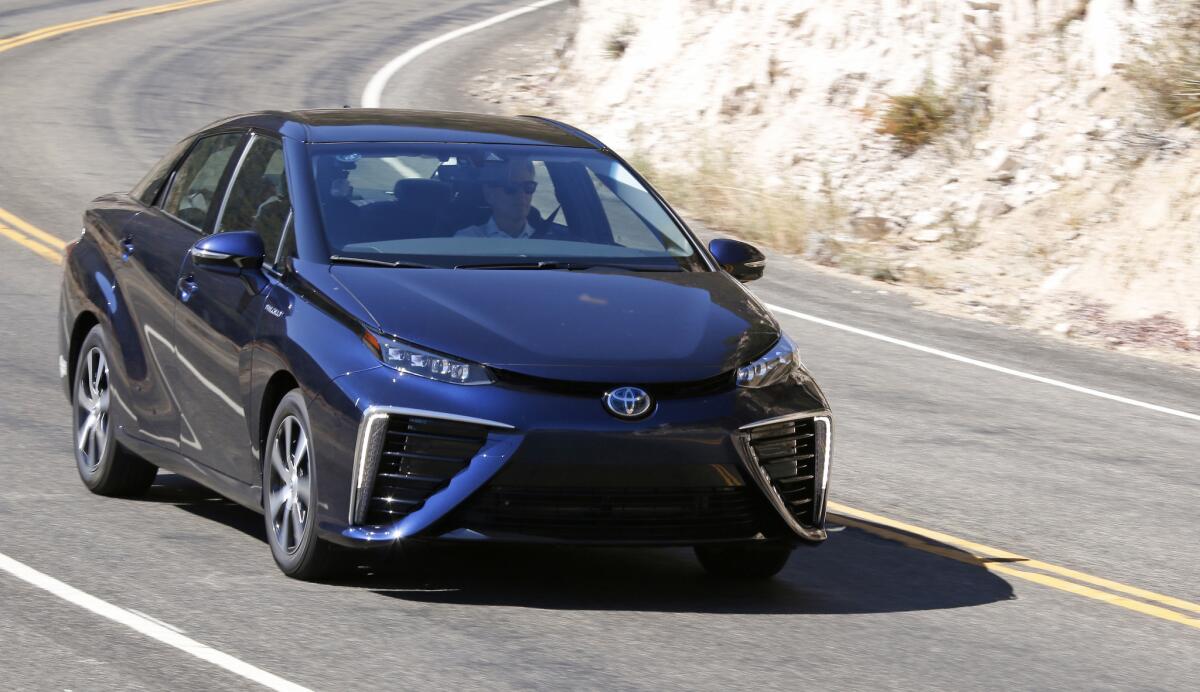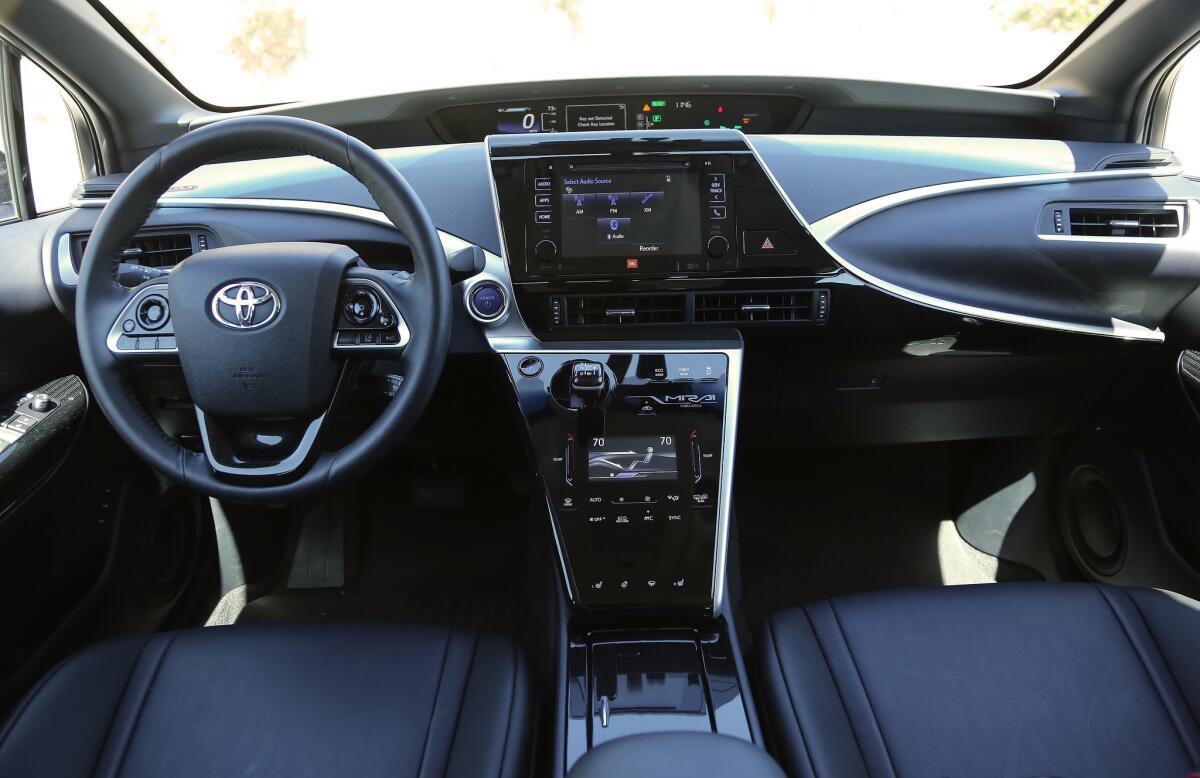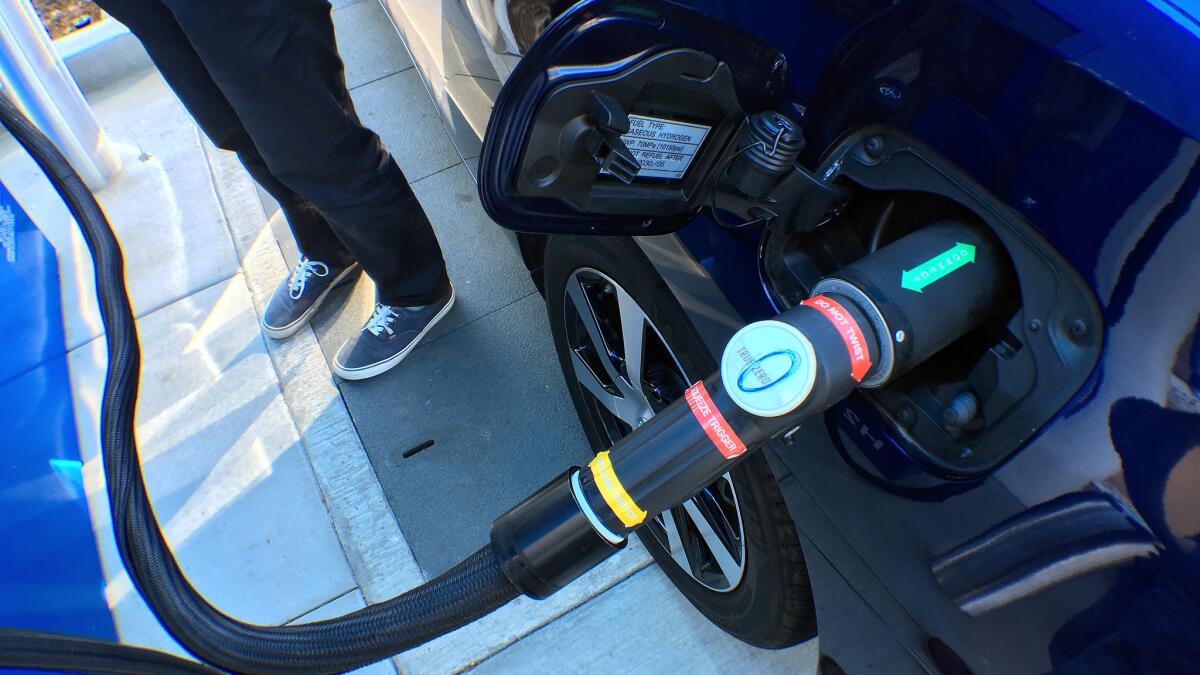Review: 2016 Toyota Mirai: A fuel cell phenom hits the road running

- Share via
The world’s car companies are all reaching for the same holy grail: a good-running, zero-emissions vehicle that has long driving range. And is affordable. And can be refueled quickly.
Toyota’s latest entry is an electric-motor vehicle that boasts a range of 312 miles and can be refueled in three to five minutes.
The catch: It’s the Mirai, Toyota’s hydrogen fuel cell vehicle. And it costs more than $50,000.
The Mirai is powered by an electric motor, but unlike the plug-in Tesla Model S, Nissan Leaf or Chevy Bolt, the Mirai’s energy is stored not in a battery but in a tank of hydrogen.
Under the hood, the hydrogen runs through a fuel stack, is mixed with oxygen, and produces the electricity that runs the motor. The only tailpipe emission is water vapor, so the Mirai doesn’t even have a tailpipe.
Like most electric cars, the Mirai is delightfully quiet. Whether around town or on the freeway, there’s no engine noise or vibration, and no sense of the electric motor doing any work except for a slight whir from the transmission.
While it’s not as zippy as a Tesla — there is no “Insane” or “Ludicrous” button, so it lopes from zero to 60 in a leisurely 9 seconds — its 113-kilowatt motor makes the equivalent of 151 horsepower and 247 pound feet of torque.
On the outside, the Mirai looks like a Camry, dressed up with sporty wheels and racier side lines, and wearing a night guard and droopy mustache.
But it’s not ugly on purpose. The blunt front end and jowly air scoops are there to protect and cool the power train.
On the inside, it feels like a mid-range, mid-size luxury sedan. Head space and leg room are generous, front and rear. The seats are nicely designed and adequately adjustable. The dash and center console make for a comfortable control center.

Toyota has outfitted the Mirai with a host of safety systems, from the expected ABS and traction control to more sophisticated brake assist, lane departure warning and rear cross traffic alert.
Best of all, unlike all the other electric motor cars with which it is expected to compete, it refuels fast. You pull the Mirai into a hydrogen filling station, just as you would a gasoline car, and pump.
That means you are back to a full tank of fuel in about five minutes. It also means Toyota will earn the maximum possible number of California pollution credits for every fast-fueling, zero-emission Mirai it sells here.
The problem: There aren’t very many fueling stations in Southern California, and it’s a tank full of hydrogen.
Most people are familiar with hydrogen. Bearing atomic number 1, it is the most abundant chemical substance in our universe, and sits at the very top of the periodic table of elements.
But most people associate it with all the wrong things: Hindenburg, or Hiroshima.
In my household, where we have a somewhat dark sense of humor, the Mirai quickly became known as the “H-Bomb.” In other households, I’m afraid it would likelier become known as, “I’m not getting into that thing.”
Toyota has been introducing the Mirai as “the future of driving.” But it has mostly stopped calling the Mirai a “hydrogen fuel cell vehicle,” and instead refers to it now as a “fuel cell vehicle.”
Fueling the Mirai is likely to induce a new kind of range anxiety. The vehicle gets an estimated 312 miles per tank, and the fueling procedure is simple, but filling the tank may require some travel.

According to the California Fuel Cell Partnership, there are 11 retail stations open in the greater Southern California area — almost half the total number nationally — with another 13 “in development.” There are some in the Bay Area, too, and halfway in between, at Harris Ranch, to help you get back and forth.
But that trip to Vegas? You can probably get there, but you may not make it back. According to the U.S. Department of Energy, there are no hydrogen fueling stations in Nevada.
Toyota has priced it at a starting MSRP of $58,335, and some buyers will qualify for tax incentives of up to $8,000. Toyota also offers a lease deal of $499 a month, for three years, after a $4,000 down payment.
To sweeten that, Toyota will also pay for all the Mirai’s hydrogen for the first three years, up to $15,000 worth. (It gives you a credit card to use at those fueling stations.)
As a further inducement, Toyota points out that the Mirai is eligible for the coveted white California HOV sticker that allows solo driver access to the carpool lane.
The company has said it expects to put about 1,000 Mirais on the road in 2016, and to sell up to 3,000 by the end of next year.
If Californians embrace fuel cell technology, and infrastructure keeps pace with demand, it’ll have company. Honda has its Clarity fuel cell vehicle coming to dealerships soon, at about the same price and lease deal as the Mirai. Hyundai’s Tucson fuel cell vehicle is available for lease. Similar vehicles could be coming from Chevrolet, Nissan, Mercedes and Audi.
2016 Toyota Mirai
Times’ take: The future is here — too soon?
Highs: Quiet, comfortable and free to fuel
Lows: Few filling stations, freaky technology
Vehicle type: Four-door, four-passenger sedan
Base price: $58,335
Price as tested: $58,335
Powertrain: 113 kW, hydrogen fuel cell
Transmission: Automatic
Horsepower: 151
Torque: 247 pound feet
EPA fuel economy rating: 67 miles per gallon equivalent city / 67 MPGe highway / 67 MPGe combined
MORE AUTO REVIEWS
Fiat 124 Spider review: It’s not a ‘Fiata’ after all
McLaren builds a car for the masses, with a $200,000 price tag
QX30 Review: Infiniti makes a play for premium SUV buyers




